Embracing Transformation: A Conversation with Christian Hecker on SAP’s oCFO Strategy for Finance Leaders
Meet the Authors
Key Takeaways
SAP's oCFO area transformation focuses on empowering finance leaders by combining powerful finance tools and fostering collaboration between finance and IT, ensuring a cohesive suite of solutions for effective decision-making.
Real-world case studies from companies like Fresenius and Lexmark demonstrate significant operational efficiencies and cost savings achieved through SAP's Cloud ERP and integrated finance solutions, showcasing their practical impact.
SAP's commitment to innovation through initiatives such as Business AI and advanced financial planning tools illustrates its vision for helping CFOs navigate current challenges and drive transformative change in the finance landscape.
Christian Hecker’s Vision for Finance Transformation at SAP
I recently had the chance to sit down with Christian Hecker, SVP, Chief Revenue Officer for the Office of the CFO (oCFO) Business at SAP. Christian stepped into this role in 2024, a move that highlights SAP’s commitment to helping CFOs navigate the ever-changing world of finance and digital transformation. According to Christian, SAP’s new oCFO area focuses on empowering finance leaders with solutions designed for today’s biggest challenges, whether that’s data-driven decision-making, staying compliant, or streamlining processes in a world that’s only getting more complex.
Redefining the oCFO Area: A New Era for SAP and CFOs
SAP is redefining its oCFO area with two main considerations: combining powerful finance tools and fostering collaboration between finance and IT.
Let’s start with combining tools. SAP brought together SAP S/4HANA Finance and RISK, Taulia, and XP&A (Extended Planning & Analysis) to support the full range of CFO responsibilities. This combined positioning means that finance leaders now have all these critical tools under one umbrella—from core accounting to cash management, regulatory compliance, and strategic planning. Instead of dealing with scattered functions, CFOs can now access a cohesive, efficient suite that gives them a single view of finance and helps them streamline everything they do.
Explore related questions
The second focus area is fostering a partnership between finance and IT. In many companies, CFOs and CIOs work side-by-side on digital transformation projects, and SAP is making that easier with its Cloud ERP and Finance offerings, supported by RISE and GROW methodologies. With Cloud ERP, CIOs can adopt technologies in new ways that go beyond just “keeping the lights on.” Cloud ERP offers capabilities for organizations to consume the SAP applications in a whole different way. This approach helps them maximize the value of SAP applications. This also means that CFOs gain easier access to most current capabilities that help drive transformations leading to growth, innovation, and resilience.
Real-World Successes with SAP’s oCFO Solutions
Christian didn’t just talk about SAP’s strategy—he also shared some real-world examples of companies seeing big wins from using these solutions:
- Fresenius: This healthcare organization took on a business transformation project with RISE with SAP. The results? They cut SAP system administration time in half and reduced their IT footprint by 20%. With SAP’s Cloud ERP, Fresenius has been able to streamline operations, become more efficient, and refocus on their core mission: patient care.
- Lexmark: Known for its print hardware and IoT solutions, Lexmark took their finance operations to the cloud. By migrating from on-premise systems, they expect a 47% boost in efficiency in accounts receivable and a >50% improvement in material requirement planning. Consolidating their data in the cloud lets them leverage insights across their supply chain and drive cost savings.
- SAP’s Internal Transformation: SAP itself is using its own finance tools to great effect. They just rolled out an automated workforce planning tool that has saved time and improved accuracy in headcount planning. Plus, with advanced financial closing tools, SAP’s finance team made reporting faster and more precise. These in-house transformations show that SAP is not only a provider but also a user of its own technology, proving it works effectively in real-world settings.
Key Innovations and Big Bets for 2025: Shaping the Future of Finance
SAP’s commitment to innovation shines through the over 500 enhancements rolled out this past year alone. From new tools for tax compliance to automated cost-center management, SAP’s ongoing improvements are aimed at helping finance teams keep pace with evolving demands. These updates reflect SAP’s commitment to making finance professionals’ lives easier by addressing their real-world challenges head-on.
Looking to the future, SAP is focused on several key innovations set to reshape the finance landscape in 2025.
- Business AI: Revolutionizing office of CFO
- SAP’s Business AI is designed to drive an impactful change in finance. Imagine being able to simply ask your system for the data you need or describe a report you’re looking for without digging through multiple screens. That’s what SAP’s AI tools are built to do—they let finance professionals interact naturally with the system, whether it’s to find a report, get cost center data, or run analysis. Christian even shared his own experiences of the days when pulling data from various sources was a time-consuming chore. Now, with AI-driven automation, it’s a smooth, seamless process.
- Business AI doesn’t stop there. It’s designed with productivity in mind. For example, accounts receivable specialists can use AI-driven support for tasks like dispute management, complete with tailored call scripts and automated email responses. These tools take the weight off finance professionals, letting them focus on strategy and insight rather than routine tasks. Christian highlighted that this approach makes the finance function more human-centered, empowering teams to do their best work.
- Financial Planning & Analysis: Real-Time Financial Insights
- SAP is also planning to double down on financial planning and analysis, giving CFOs better control over real-time data and insights. With advanced tools for financial steering, SAP’s solutions help finance leaders make decisions based on real numbers and trends. This means finance leaders can align finance with broader business goals, ensuring that strategy and performance go hand-in-hand.
- Taulia taking Treasury Management to the next level
- Treasury management is another big focus, and SAP’s integration with Taulia takes it to the next level. By bringing Taulia’s cash and treasury solutions together, finance teams gain powerful tools to optimize cash flow, streamline payments, and manage liquidity in real-time. As Christian pointed out, SAP’s end-to-end treasury capabilities offer treasurers the control they need to make smarter, faster decisions in today’s dynamic market.
Conclusion: A New Path Forward for Finance Leaders with SAP
SAP’s vision for finance transformation is about much more than adapting to today’s challenges—it’s about anticipating the future. As finance leaders face increasing demands for agility, resilience, and data-driven insights, SAP’s oCFO solutions provide the foundational tools to transform finance from a support function into a strategic powerhouse.
By actively listening to its customers, SAP continues to evolve its solutions in line with the trends reshaping the finance world, from automation and AI to integrated end-to-end solution set and real-time analytics. For CFOs and finance teams, this means having the confidence to navigate rapid changes, the tools to drive continuous improvement, and the insights to make proactive decisions.
As Christian Hecker put it, SAP’s oCFO strategy is about creating a finance function that doesn’t just react but leads—helping organizations thrive in an increasingly digital, complex, and interconnected world. The future of finance is already being built, and SAP is here to help finance leaders shape it.









